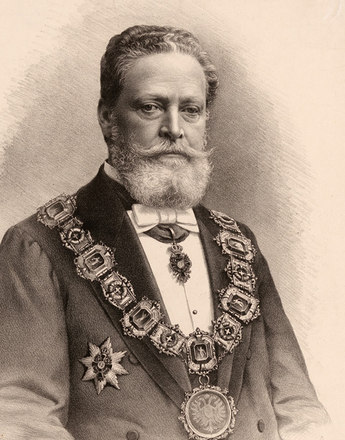‘An important day in the history of the world is over. From close up it does not look that wonderful.’ (Entry in the diary of Arthur Schnitzler)
In the First Republic the strong polarization between the working class and the bourgeoisie as well as the deep political mistrust between the Social Democrat and Christian Socialist parties also found expression in a divided culture of memory and in divided attitudes towards the most important sites of memory in the political world of the First Republic.
Commemorative events held by the Social Democrats in the form of mass demonstrations, such as that marking the opening of the monument to the republic in 1928, led to violent confrontations between the conservative Heimwehr and the socialist Schutzbund militias. On the other hand the regime of the corporate state, which saw the years between 1918 and 1934 as an ‘unfortunate, un-Austrian interregnum’, resorted to political narratives and symbols of state which aimed to idealize the monarchy. For example, in 1933 Engelbert Dollfuss spoke about it being a matter of urgency ‘to dispose of the rubble of revolution and to establish links once more with the finest periods of history’. In 1934 the ceremonies marking the founding of the republic on 12 November 1918 were banned, and in 1935 the Habsburg law of 1919 was repealed.
In the period of reconstruction in Austria after the end of the Second World War the function of 12 November 1918 (the date of the proclamation of the Republic of Austria) as a site of political memory directed against the Austrian bourgeoisie became less and less important. This was above all the result of the ‘coalition peace’ between the two ruling parties, the socialist SPÖ and the conservative ÖVP. The pursuit of shared interests above those of the individual parties was intended to prevent the resurgence of the deep political conflicts of the First Republic. The two coalition parties now came to see the First Republic more and more as a negative counterpart to the political and economic development of the Second Republic. While the First Republic was represented as a story of failure, the Second Republic was regarded as a success story. Symptomatic of this approach was a statement by Bruno Kreisky, who while Chancellor, speaking at a party event held in 1978, expressed the opinion that the ‘state that nobody wanted has turned into the state that everyone wants’.
After 1945 there was no question of making 12 November 1945 the national holiday. Karl Renner argued that in any case November was not a good time for celebrations because it was likely that the weather would be bad. In 1965 it was agreed that 26 October, the day when in 1955 the federal constitutional law on Austria’s permanent neutrality was passed, should become the national holiday. From 1948 the proclamation of the First Republic was remembered every ten years in official ceremonies organised by the government, but the commemoration day became less and less important for the two major parties.
Picture caption: ‘Mass procession with flags and banners on the Ringstrasse near the Parliament building’. (NB: Flags and banners can hardly be made out.)
Translation: Leigh Bailey
Cole, Laurence: Der Habsburger-Mythos in: Brix, Emil et al.: (Hrsg.): Memoria Austriae I. Menschen, Mythen, Zeiten. Wien 2004, 473-504
Rasky, Bela: Erinnern und Vergessen der Habsburger in Österreich und Ungarn nach 1918, in Müller, Karl (Hrsg.): Österreich 1918 und die Folgen. Geschichte, Literatur, Theater und Film, Wien u.a. 2009, 25-58
Reisacher Martin: Die Konstruktion des „Staats, den keiner wollte“. Der Transformationsprozess des umstrittenen Gedächtnisorts „Erste Republik“ in einen negativen rhetorischen Topos. Diplomarbeit Wien 2010. Unter: http://othes.univie.ac.at/10190/1/2010-06-07_0252520.pdf (20.6.2014)
Quotes:
„An important day in the history of the world ...": Pfoser, Alfred: Was nun? Was tun? Zehn Blitzlichter zur literarischen Szene der Jahre 1918 bis 1920, in: Konrad, Helmut/Maderthaner, Wolfgang (Hrsg.,) Das Werden der Ersten Republik Bd. I, ... Der Rest ist Österreich, Wien 2008, 173-196, hier 176 (Translation)
„to dispose of the rubble of revolution ...": zitiert nach: Rasky, Bela: Erinnern und Vergessen der Habsburger in Österreich und Ungarn nach 1918, in Müller, Karl (Hrsg.): Österreich 1918 und die Folgen. Geschichte, Literatur, Theater und Film, Wien u.a. 2009, 31 (Translation)
„state that nobody wanted ...": AZ, 12.11.1978, 1 (Translation)
-
Chapters
- 12 November 1918 as a Site of Memory
- The New State in Search of its National Holiday: 12 November as the Site of Political Dividing Lines
- Austria, the Country without a National Anthem
- Disputed Zones: Monuments and Street Names
- Myths and Narratives: ‘The Rest is Austria!’ … or something like that
- Myths and Narratives: ‘The Reluctant State’ and ‘The State that Nobody Wanted’
- No Role to Play and yet part of Austria’s Heritage: the Habsburgs after 1918








